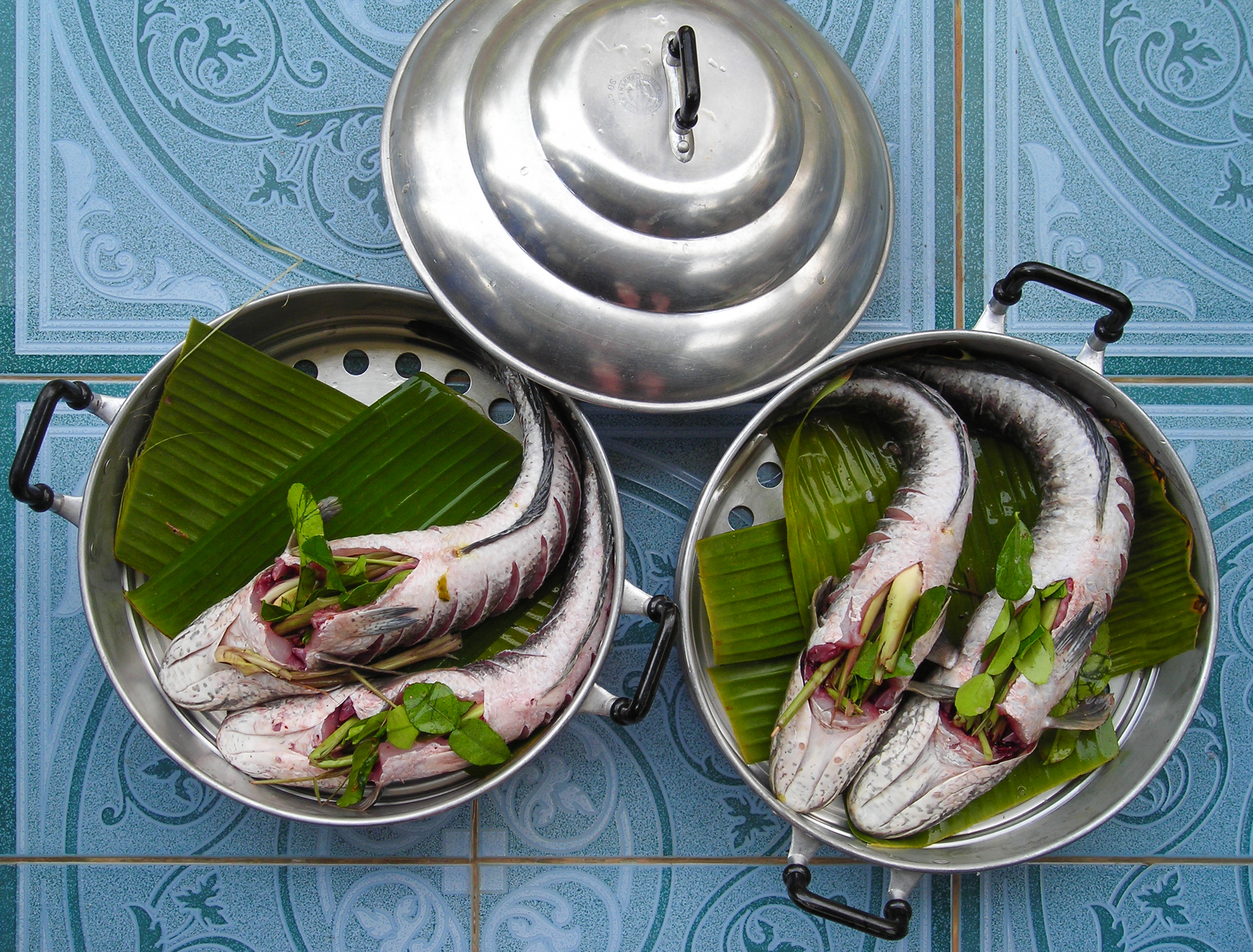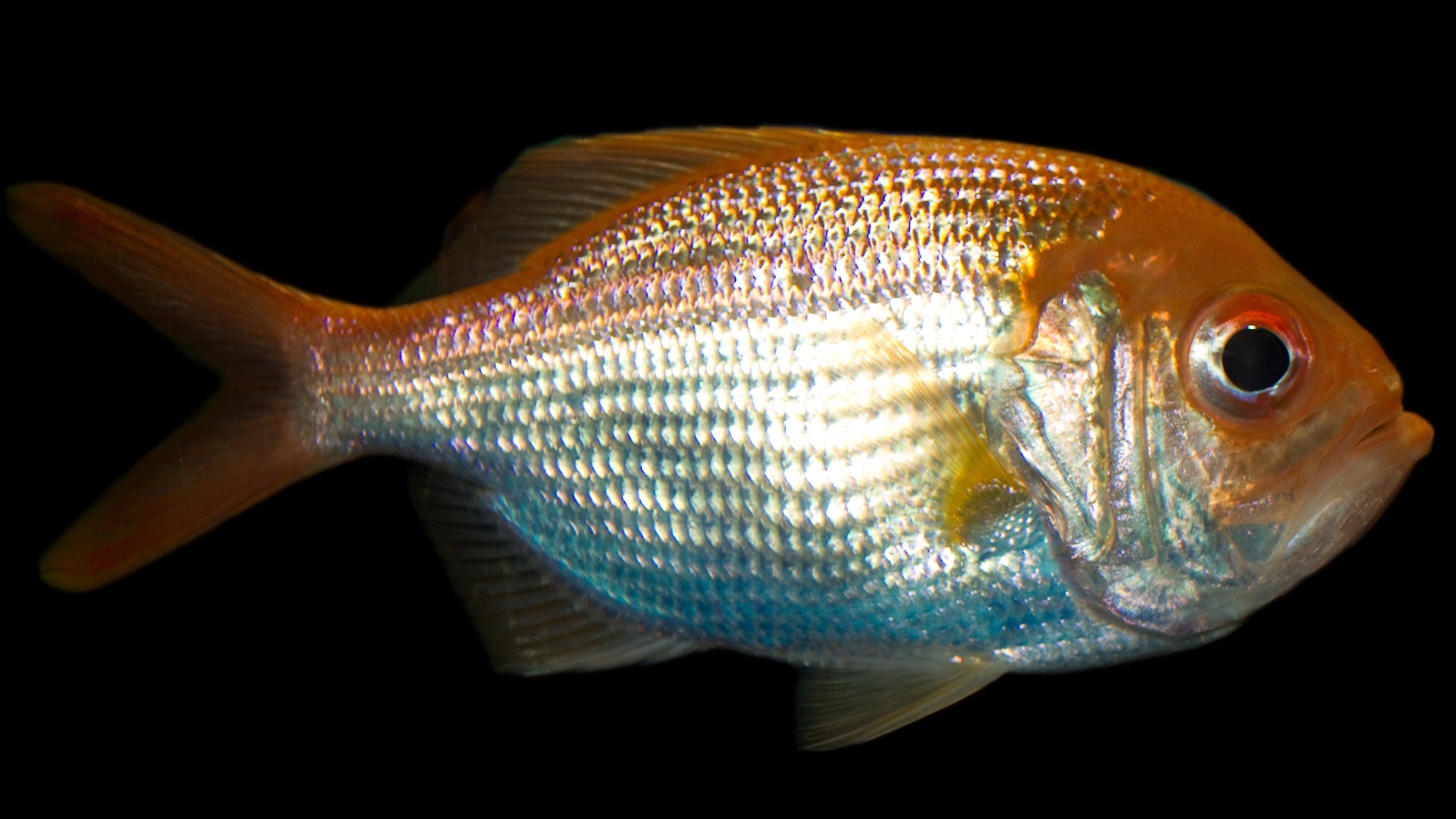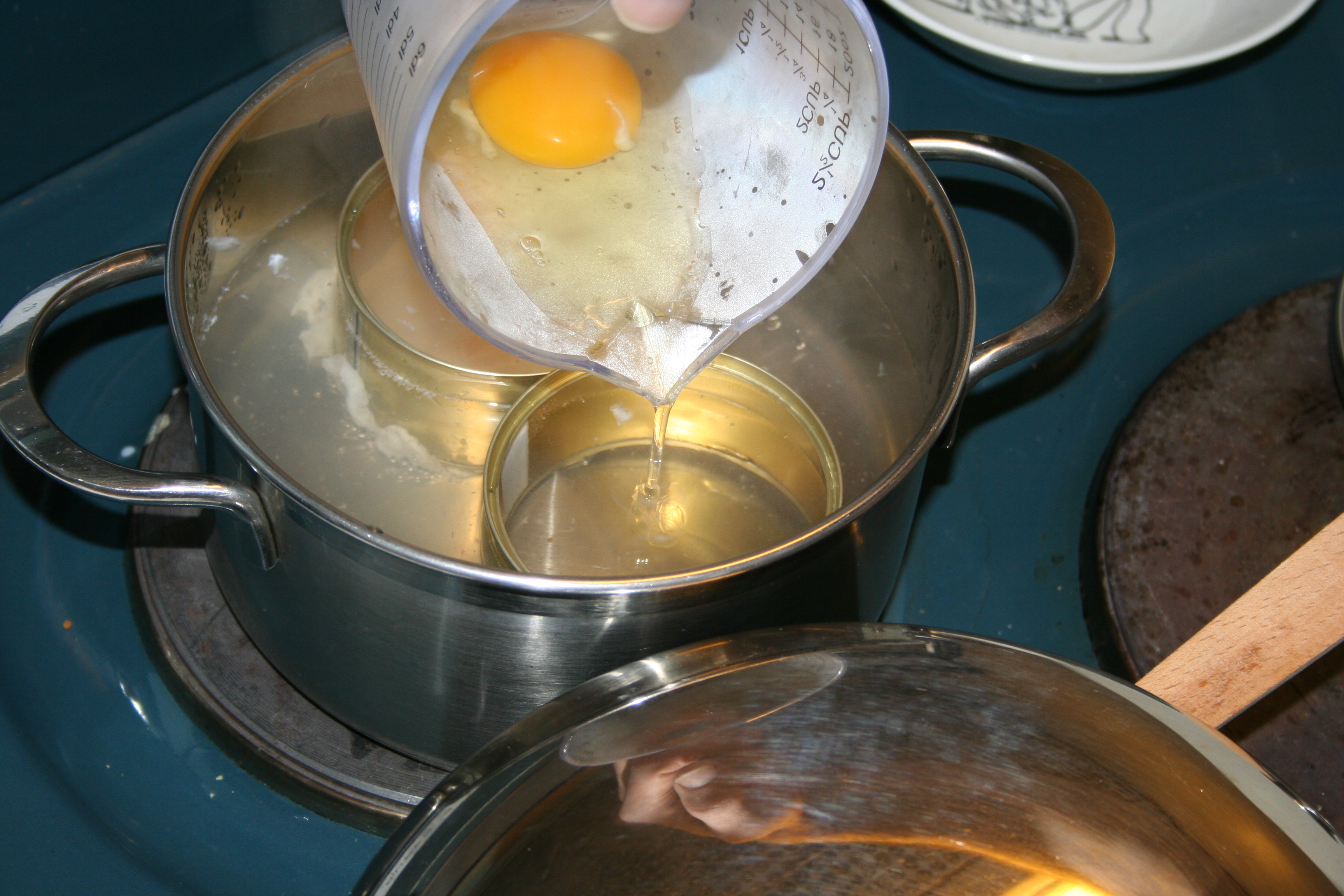|
Court-bouillon
Court-bouillon or court bouillon (in Louisiana, pronounced ''coo-bee-yon'') is a quickly-cooked broth used for poaching other foods, most commonly fish or seafood. It is also sometimes used for poaching vegetables, eggs, sweetbreads, cockscombs, and delicate meats. It includes seasonings and salt but lacks animal gelatin. Description Court bouillon loosely translates as 'briefly boiled liquid' (French ''court'') or "short broth" because the cooking time is brief in comparison with a rich and complex stock, and generally is not served as part of the finished dish. Because delicate foods do not cook for very long, it is prepared before the foods are added. Typically, cooking times do not exceed 60 minutes. Although a court bouillon may become the base for a stock or fumet, in traditional terms it is differentiated by the inclusion of acidulating ingredients such as wine, vinegar, or lemon juice. In addition to contributing their own flavor, acids help to draw flavors from the ... [...More Info...] [...Related Items...] OR: [Wikipedia] [Google] [Baidu] |
Nage (food)
Nage is the term used in the USA and everywhere else in the culinary world (French word) for a flavored liquid used for poaching delicate foods, typically seafood. A traditional nage is a broth flavored with white wine, vegetables, and herbs, in which seafood is poached. The liquid is then reduced and thickened with cream and/or butter. Background Cooking something ''à la nage'' translates as “while swimming” ( French ''nage'') and refers to cooking in a well-flavored court-bouillon. Eventually the term "nage" itself came to refer to a broth which, while light, is strong enough to be served as a light sauce with the dish itself, unlike a court-bouillon which is omitted. Additional ingredients such as tomatoes are sometimes added. See also * Demi-glace Demi-glace (, 'half glaze') is a rich brown sauce in French cuisine used by itself or as a base for other sauces. The term comes from the French word ''glace'', which, when used in reference to a sauce, means "icing" or "gla ... [...More Info...] [...Related Items...] OR: [Wikipedia] [Google] [Baidu] |
Fish (food)
Many species of fish are caught by humans and consumed as food in virtually all regions around the world. Fish has been an important dietary source of protein and other nutrients throughout human history. The English language does not have a special culinary name for food prepared from fish like with other animals (as with '' pig'' vs. ''pork''), or as in other languages (such as Spanish ''pez'' vs. '' pescado''). In culinary and fishery contexts, ''fish'' may include so-called shellfish such as molluscs, crustaceans, and echinoderms; more expansively, seafood covers both fish and other marine life used as food. Since 1961, the average annual increase in global apparent food fish consumption (3.2 percent) has outpaced population growth (1.6 percent) and exceeded consumption of meat from all terrestrial animals, combined (2.8 percent) and individually (bovine, ovine, porcine, etc.), except poultry (4.9 percent). In '' per capita'' terms, food fish consumption has grown from i ... [...More Info...] [...Related Items...] OR: [Wikipedia] [Google] [Baidu] |
Comb (anatomy)
A comb is a fleshy growth or crest on the top of the head of some gallinaceous birds, such as domestic chickens. The alternative name cockscomb (with several spelling variations) reflects the fact that combs are generally larger on cock birds than on hens. The comb is one of several fleshy protuberances on the heads of chickens, the others being the wattles and earlobes, which collectively are called caruncles. In turkeys, the caruncles are the fleshy nodules on the head and throat. Chicken combs are most commonly red, but may also be black or dark purple in breeds such as the Silkie or the Sebright. In other species the color may vary from light grey to deep blue or red. The comb may be a reliable indicator of health or vigor and is used for mate-assessment in some poultry species. Types of chicken comb Comb shape varies considerably depending on the breed or species of bird. Of the many types and shapes seen in chicken cocks the principal ones are: * the single comb, ... [...More Info...] [...Related Items...] OR: [Wikipedia] [Google] [Baidu] |
Poached Halibut In A Sesame Court Bouillon
Poaching is illegal hunting or fishing. Poaching, poacher, or poach may also refer to: Food * Poaching (cooking) * Lincolnshire Poacher cheese, a cheese from the United Kingdom **The Lincolnshire Poacher Sport * Poach (pickleball), a type of shot in the sport of pickleball * Poaching (snowboarding), snowboarding at a resort where snowboards are explicitly prohibited. * Poaching (tennis), when a doubles player aggressively moves across the court to volley a ball intended for their partner. * Poacher 21, an American sailboat design * Goal poacher, in association football Other uses * ''Poacher'' (film), a 2018 British-Kenyan film * Poacher (fish), a family (Agonidae) of fish * Mate poaching in animals, seduction of an animal who has already established a bond with another creature ** Human mate poaching, in human infidelity * Poacher Line, a railway line in Lincolnshire, United Kingdom See also * Antipoaching Antipoaching is an anti-competitive conduct where companies consp ... [...More Info...] [...Related Items...] OR: [Wikipedia] [Google] [Baidu] |
Salt
Salt is a mineral composed primarily of sodium chloride (NaCl), a chemical compound belonging to the larger class of salts; salt in the form of a natural crystalline mineral is known as rock salt or halite. Salt is present in vast quantities in seawater. The open ocean has about of solids per liter of sea water, a salinity of 3.5%. Salt is essential for life in general, and saltiness is one of the basic human tastes. Salt is one of the oldest and most ubiquitous food seasonings, and is known to uniformly improve the taste perception of food, including otherwise unpalatable food. Salting, brining, and pickling are also ancient and important methods of food preservation. Some of the earliest evidence of salt processing dates to around 6,000 BC, when people living in the area of present-day Romania boiled spring water to extract salts; a salt-works in China dates to approximately the same period. Salt was also prized by the ancient Hebrews, Greeks, Romans, Byzantines, ... [...More Info...] [...Related Items...] OR: [Wikipedia] [Google] [Baidu] |
Larousse Gastronomique
' () is an encyclopedia of gastronomy. The majority of the book is about French cuisine, and contains recipes for French dishes and cooking techniques. The first edition included few non-French dishes and ingredients; later editions include many more. The book was originally published by Éditions Larousse in Paris in 1938. Background The first edition (1938) was edited by Prosper Montagné, with the collaboration of Dr Alfred Gottschalk, with prefaces by each of author-chefs Georges Auguste Escoffier and Philéas Gilbert (1857-1942). Gilbert was a collaborator in the creation of this book as well as ''Le Guide Culinaire'' (1903) with Escoffier, leading to some cross-over with the two books. It caused Escoffier to note when he was asked to write the preface that he could "see with my own eyes," and "Montagné cannot hide from me the fact that he has used ''Le Guide'' as a basis for his new book, and certainly used numerous recipes." The third English edition (2001), which runs ... [...More Info...] [...Related Items...] OR: [Wikipedia] [Google] [Baidu] |
Roux
Roux () is a mixture of flour and fat cooked together and used to thicken sauces. Roux is typically made from equal parts of flour and fat by weight. The flour is added to the melted fat or oil on the stove top, blended until smooth, and cooked to the desired level of brownness. A roux can be white, blond (darker) or brown. Butter, bacon drippings or lard are commonly used fats. Roux is used as a thickening agent for gravy, sauces, soups and stews. It provides the base for a dish, and other ingredients are added after the roux is complete. Uses The fat is most often butter in French cuisine, but may be lard or vegetable oil in other cuisines. Roux is used in three of the five mother sauces of classic French cooking: béchamel sauce, velouté sauce, and espagnole sauce. In Cajun cuisine, roux is made with lard, oil, or meat, poultry, or bacon drippings instead of butter. It is often cooked to a medium or dark brown color, which lends much richness of flavor, but makes it th ... [...More Info...] [...Related Items...] OR: [Wikipedia] [Google] [Baidu] |
Redfish
Redfish is a common name for several species of fish. It is most commonly applied to certain deep-sea rockfish in the genus ''Sebastes'', red drum from the genus ''Sciaenops'' or the reef dwelling snappers in the genus ''Lutjanus''. It is also applied to the slimehead Slimeheads, also known as roughies and redfish, are mostly small, exceptionally long-lived, deep-sea beryciform fish constituting the family Trachichthyidae (derived from the Greek ''trachys'' – "rough" and ''ichthys'' – "fish"). Found in tem ...s or roughies (family Trachichthyidae), and the alfonsinos (Berycidae). References {{Animal common name Fish common names ... [...More Info...] [...Related Items...] OR: [Wikipedia] [Google] [Baidu] |
Poached Egg
A poached egg is an egg that has been cooked, outside the shell, by poaching (or sometimes steaming), as opposed to simmering or boiling. This method of preparation can yield more delicately cooked eggs than cooking at higher temperatures such as with boiling water. Preparation The egg is cracked into a cup or bowl of any size, and then gently slid into a pan of water at approximately 75° C (167 °F) and cooked until the egg white has mostly solidified, but the yolk remains soft. The "perfect" poached egg has a runny yolk, with a hardening crust and no raw white remaining. In countries that mandate universal salmonella vaccination for hens, eating eggs with a runny yolk is deemed safe for consumption. Broken into water at the poaching temperature, the white will cling to the yolk, resulting in cooked egg white and runny yolk. Any given chicken egg contains some egg white that is prone to dispersing into the poaching liquid and cooking into an undesirable foam. To prevent this, ... [...More Info...] [...Related Items...] OR: [Wikipedia] [Google] [Baidu] |
Bay Leaf
The bay leaf is an aromatic leaf commonly used in cooking. It can be used whole, either dried or fresh, in which case it is removed from the dish before consumption, or less commonly used in ground form. It may come from several species of tree, the bay laurel and the California bay tree being the most common. The flavor that a bay leaf imparts to a dish has not been universally agreed upon, but most agree it is a subtle addition. Sources Bay leaves come from several plants, such as: *Bay laurel (''Laurus nobilis'', Lauraceae). Fresh or dried bay leaves are used in cooking for their distinctive flavour and fragrance. The leaves should be removed from the cooked food before eating (see safety section below). The leaves are often used to flavour soups, stews, braises and pâtés in many countries. The fresh leaves are very mild and do not develop their full flavour until several weeks after picking and drying. *California bay leaf. The leaf of the California bay tree (''Umbel ... [...More Info...] [...Related Items...] OR: [Wikipedia] [Google] [Baidu] |
Thyme
Thyme () is the herb (dried aerial parts) of some members of the genus ''Thymus'' of aromatic perennial evergreen herbs in the mint family Lamiaceae. Thymes are relatives of the oregano genus ''Origanum'', with both plants being mostly indigenous to the Mediterranean region. Thymes have culinary, medicinal, and ornamental uses, and the species most commonly cultivated and used for culinary purposes is ''Thymus vulgaris''. History Thyme is indigenous to the Mediterranean region. Wild thyme grows in the Levant, where it might have been first cultivated. Ancient Egyptians used thyme for embalming. The ancient Greeks used it in their baths and burnt it as incense in their temples, believing it was a source of courage. The spread of thyme throughout Europe was thought to be due to the Romans, as they used it to purify their rooms and to "give an aromatic flavour to cheese and liqueurs". In the European Middle Ages, the herb was placed beneath pillows to aid sleep and ward off ni ... [...More Info...] [...Related Items...] OR: [Wikipedia] [Google] [Baidu] |
Lobster
Lobsters are a family (biology), family (Nephropidae, Synonym (taxonomy), synonym Homaridae) of marine crustaceans. They have long bodies with muscular tails and live in crevices or burrows on the sea floor. Three of their five pairs of legs have claws, including the first pair, which are usually much larger than the others. Highly prized as seafood, lobsters are economically important and are often one of the most profitable commodities in coastal areas they populate. Commercially important species include two species of ''Homarus'' from the northern Atlantic Ocean and scampi (which look more like a shrimp, or a "mini lobster")—the Northern Hemisphere genus ''Nephrops'' and the Southern Hemisphere genus ''Metanephrops''. Distinction Although several other groups of crustaceans have the word "lobster" in their names, the unqualified term "lobster" generally refers to the clawed lobsters of the family Nephropidae. Clawed lobsters are not closely related to spiny lobsters o ... [...More Info...] [...Related Items...] OR: [Wikipedia] [Google] [Baidu] |


.jpg)




